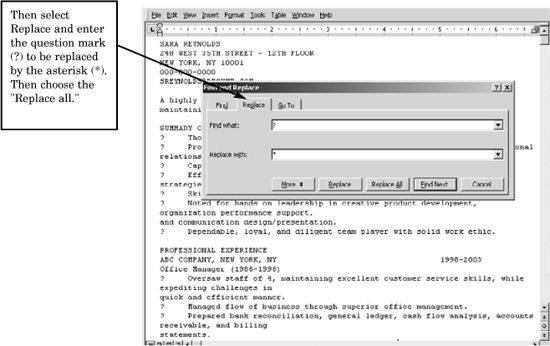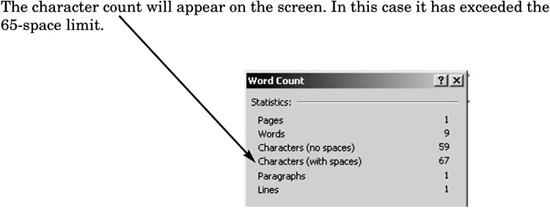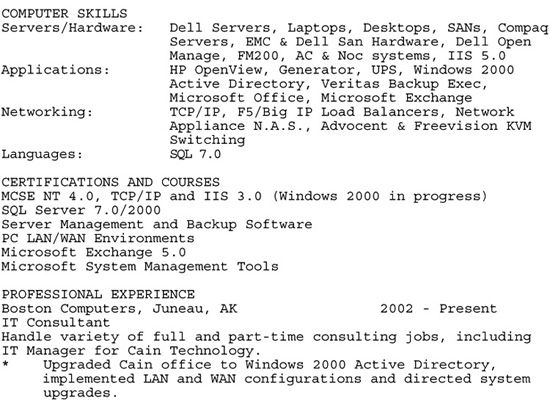The Resume.Com Guide to Writing Unbeatable Resumes (17 page)
Read The Resume.Com Guide to Writing Unbeatable Resumes Online
Authors: Warren Simons,Rose Curtis




Make sure that all dashes are still dashes and that the dates are aligned. Now copy and paste the formatted ASCII resume into the e-mail you send to hirers. This formatted document should be cut and pasted directly below your cover letter.

We recommend e-mailing the resume to yourself first to verify that the formatting is clear. This highly readable version, you’ll notice, won’t be as attractive as a nicely formatted resume, but sometimes it’s a matter of form following function.
Another benefit of the ASCII resume is its ability to be scanned easily by optical character recognition (OCR) software. As we indicated in the discussion of the keywords section in Chapter 7, job applicants often send resumes that can’t be read by OCR software. To ensure that the content of your resume, which is the key to any interview, is reviewed, heed the words of communications theorist Marshall McLuhan: “The medium is the message.” Make sure you’re adhering to the rules of the medium, and the results will follow.
OCR software cannot read certain types of fonts or symbols commonly used in many resumes, and so it’s best to have two versions of your resume: one for applying online and another for handing out at job fairs or giving directly to a potential employer.
Otherwise, you’ll waste a lot of time sending out resumes that are not being read. And that’s before the competition even starts.
The three most common methods of applying for an advertised position are by fax, e-mail, and the U.S. Postal Service. Although there’s the story of the candidate who sealed his resume between two panels of glass and airmailed it to an overseas architecture firm—and received an interview—most companies are looking for a fast, easy, and safe way to review resumes. Paste your resume into the body of the e-mail; if an employer likes it, he or she may print it out or request a revised, Word-formatted version. To be on the safe side, many candidates send two e-mails: one with the resume cut and pasted into the body of the e-mail and a second with a non-ASCII attachment.
When resumes are faxed or mailed to a hirer, they can be scanned and stored into a database automatically for later review using OCR software, as we discussed in Chapter 7. Sending in a resume that contains graphics, is photocopied or printed on dark paper, or uses certain fonts or characters (such as lines or bold) can result in a document that can’t be scanned and will be passed over. Make sure to save your resume in a serif-free font, remove any visual interference, and align the document to the left margin.
Every resume needs a strong cover letter, and whether you’re applying for a job online or offline, this is a rule that should never be broken. Compared with a standard cover letter, an Internet cover letter can be a bit shorter. As with all cover letters, you should target the position by researching the company you are applying to and discussing the qualifications that you possess that are directly related to the job opening. For a step-by-step overview of creating cover letters, see Chapter 16.
The following example shows what an ASCII resume should look like. This candidate is in the information technology (IT) field.




Note that the ASCII format does not produce the most aesthetically pleasing document. There is neither formatting nor styling elements in this sample. However, an ASCII-formatted resume is an important tool in your job search, and this pared-down document will pass through e-mail accounts that may not accept attachments and will be clear to hirers that use varying computer platforms. Even if you are not technically savvy, the bottom line is that the ASCII format is the best way to guarantee that hirers will read your resume. (Always bring a formatted resume to an interview.)
Many recruiters now use the Internet as the sole source for finding new hires, and the reliance of companies on this medium is growing. It is relatively easy to transform your resume from an aesthetically pleasing Word document to an ASCII resume, and in the global job market you should always have two resumes available. Most important, be prolific! Perseverance is key. The more resumes you send out, the better chance you’ll have of hearing from an employer. Don’t count on one resume doing the trick; remember that following these tips will allow your resume to be seen.
The Inside Scoop on Job Boards
The job board is one of the most popular avenues for advertising new positions, and it also has allowed job seekers (both employed and unemployed) to post their resumes for all hirers to see, democratizing the job process to some extent. The efficiency and ease job boards have brought to the hiring process have allowed employment sites such as HotJobs.com, Monster.com, and Careerbuilder.com to get a foothold in the marketplace and expand rapidly. With incredible volumes of posted resumes and with employers finding the process easier and cheaper than the standard newspaper, this option has proved to be a success for job applicants in the global economy. However, this democratization process also has resulted in a steady increase in competition, meaning that professionals now must navigate a new horizon.
Whereas $150 might have bought an employer four lines in a newspaper five years ago, that amount now allows an employer to post a help wanted ad online for a month, reaching 500,000 visitors a day as opposed to the daily circulation of a single newspaper. More companies are departing from traditional media and posting job openings with interactive media, and the employment market continues to see dramatic shifts in the ways job seekers find job openings and apply for them. This also means that their resumes must adapt to the requirements of modern hiring practices or face elimination.
In today’s electronic job market hiring managers can scan thousands of resumes in seconds, employers can send out job openings to thousands of applicants instantaneously, and job seekers can target entire industries or a single position at the click of a button. As Sunday help wanted ads yield to keyword searches, 1,000 applicants can now be rejected by a computer without a human being ever seeing one of their resumes, as we discussed in Chapter 7.
